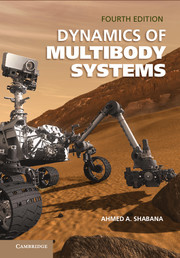Book contents
- Frontmatter
- Dedication
- Contents
- PREFACE
- 1 INTRODUCTION
- 2 REFERENCE KINEMATICS
- 3 ANALYTICAL TECHNIQUES
- 4 MECHANICS OF DEFORMABLE BODIES
- 5 FLOATING FRAME OF REFERENCE FORMULATION
- 6 FINITE-ELEMENT FORMULATION
- 7 THE LARGE DEFORMATION PROBLEM
- 8 CONCEPTS AND ESSENTIAL DETAILS
- APPENDIX: LINEAR ALGEBRA
- References
- Index
2 - REFERENCE KINEMATICS
Published online by Cambridge University Press: 05 June 2014
- Frontmatter
- Dedication
- Contents
- PREFACE
- 1 INTRODUCTION
- 2 REFERENCE KINEMATICS
- 3 ANALYTICAL TECHNIQUES
- 4 MECHANICS OF DEFORMABLE BODIES
- 5 FLOATING FRAME OF REFERENCE FORMULATION
- 6 FINITE-ELEMENT FORMULATION
- 7 THE LARGE DEFORMATION PROBLEM
- 8 CONCEPTS AND ESSENTIAL DETAILS
- APPENDIX: LINEAR ALGEBRA
- References
- Index
Summary
While a body-fixed coordinate system is commonly employed as a reference for rigid components, a floating coordinate system is suggested for deformable bodies that undergo large rotations. When dealing with rigid body systems, the kinematics of the body is completely described by the kinematics of its coordinate system because the particles of a rigid body do not move with respect to a body-fixed coordinate system. The local position of a particle on the body can then be described in terms of fixed components along the axes of this moving coordinate system. In deformable bodies, on the other hand, particles move with respect to the selected body coordinate system, and therefore, we make a distinction between the kinematics of the coordinate system and the body kinematics.
Fundamental to any presentation of kinematics is an understanding of the rotations in space. This chapter, therefore, is devoted mainly to the development of techniques for describing the orientation of the moving body coordinate system in space. A coordinate system, called hereafter a reference, is a rigid triad vector whose motion can be described by the translation of the origin of the triad and by the rotation about a line deined in the inertial coordinate system. One may then conclude that if the origin of the body reference is fixed with respect to the inertial frame, the only remaining motion is the rotation of the body reference.
- Type
- Chapter
- Information
- Dynamics of Multibody Systems , pp. 28 - 82Publisher: Cambridge University PressPrint publication year: 2013

